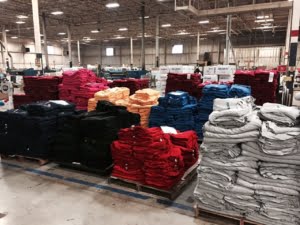Recently I had a conversation with someone regarding the future of the t-shirt printing industry during a shop tour of Visual Impressions. The whole digital vs. traditional for t-shirt printing is good fodder for an article to explore where the future of this great industry is headed. Here goes:
Digital Printing is the future, it’s that simple. Many traditional screen-printers scoff at the idea of using a digital printer as it’s not their craft that they’ve spent years mastering and seems like cheating. There is a love affair (maybe a love/hate affair would be more accurate) with the craftsmanship of pulling a squeegee and printing something. Printers look at digital technology and complain that it doesn’t look right, the hand is different, the print speeds are too slow, and that the equipment is too expensive. They argue that digital printers can’t handle specialty inks, technical fabrics, or some garments such as hoodies.
At one point all that may have been true. However, as time progresses new technological features with digital printers will address all of these points and more. Print speeds now are already over 300 per hour and that will increase further as print head technology expands. Many brands of printers have the pretreatment step built into the printer so the extra pretreatment step outside of the print run will be a thing of the past. Soon we’ll see Hexachrome ink systems instead of traditional CMYK, so color reproduction will become more accurate. Also, there’s no reason to think that DTG print manufacturers won’t be able to add another slot for specialty ink either. They want to sell you ink too.
Walk out into your shop and stand in the back corner. Survey everything it takes to support printing one t-shirt order with traditional screen-printing. Your customer service person had to take the order and enter it into the system. Your art staff had to take (or develop) the art file and separate it into the individual colors for printing. Each screen had to be specifically made for each color with steps for coating the screen, exposing the screen, washing out the emulsion, quality control & taping. Production staff had to schedule the job, bring the screens and ink to the press. If there were Pantone color to match, you may have had to mix the ink and get that to the press. Set up and register the screens, get approval and print. The job is checked off against the work order and shipped. Count all the people that touched that job. In some shops that might have just been one person (think of the time spent though), but in others it could have been 10-12 or more.
Now let’s think about a digital workflow of the future (or even right now to some degree). Your customer places an order online. The artwork is created online via your website and is automatically ripped using software that is instantly queued into the digital printer spool on your shop floor. The inventory is pulled via electronic text message, and brought to your print station. The DTG press operator prints the job and the packing list. The job is checked off against an electronic work order and shipped. A lot of traditional printing workflow steps are eliminated altogether. One person could handle this entire order, but for larger shops maybe the number of people touching the order is now three or so.
The interesting thing about a digital print order is that not only does it have the capability of having lower transactional costs, but also lower production and labor costs as well. The really big challenge currently is in the astronomical costs of the ink, and with more industry players and competition that should eventually fall too. (At least that’s what me and every other DTG print user hopes)
Also, a direct to garment printer has a lighter footprint in the shop. There is considerably less infrastructure to support, so more start-ups and other non-traditional printers will acquire them to build their business. You don’t need the hassles of the screen room, or an art staff trained in high-end simulated process techniques to print amazing looking shirts. Also, in an industry where customer order turn times are shrinking, the ability to get that order up and running and out the door quickly is a competitive edge.
In any industry, if the innovation makes something easier, more and more people will be drawn to it. In fact, I can see a day when a traditional retailer that might have once engaged in print buying, decides to go vertical and just print their shirts themselves using DTG technology with an on-demand sales vertical process. Why stock printed inventory when you can just print it for each order? In fact, that day is already here with some online retailers.
Direct to garment printing is a different animal. It prints differently on the shirt. Feels differently on the shirt. Sometimes it even smells differently. However, the power of the DTG process is getting the image on the shirt quicker and more efficiently. As it becomes more commonplace, consumers will accept the differences. A good chunk of them just want a cool looking shirt…they don’t care how it was printed. If your shop hasn’t invested in the future, or you are a traditionalist that still clings to the “old ways” of pulling a squeegee, one day in the near future you just may look up and realize that your customer base has migrated somewhere else.
So what do you think? Agree with this? Disagree? I’d love to hear from you!! Leave your thoughts in the comment section!




8 comments
Brad Strickland
I am a owner operator with one full time guy and one of those that don’t want it to be true but ultimately, I guess I agree. And I am smart enough to see that it will eventually be the future. So, the next question is, are you hiring?Because it sounds as though I should stop paying the lease on the automatic and go work for someone else, and if you are hiring what will my future be with your company once you start going digital and no longer need the guy skilled in simulated process separations or the 16 machine operators and all of the people that support them. What will happen to all the minimum wage jobs like catching shirts and cleaning screens that the after school or college student currently fills? I am afraid for the future. Is progress always a good thing?
atkinsontshirt
Brad – the industry is changing…but maybe not lightning fast. As with any production equipment, machines take the labor out if the equation with more efficiency. Is this good for business? Yes. Is it good for the $9 an hour worker that doesn’t have skills? Probably not. While I don’t think everything is doom and gloom, it is best to be on the prepared side of things.
customsg
yeah i agree with you DTG is the future technique of t shirt printing.. great article..
http://custom.sg/print-tshirt
Jan Kyselák
Thank you for this great article. Speaking about the built-in pretreatment, I only know about Kornit machines, do you know any other ? I am going to TecStyle Visions (Stuttgart) next week to take a look at the new Epson but I still like more Kornit especially for the built in pretreatment. But the price difference is so big…The new Epson costs here in Europe about USD 23.000,- and the smalest Kornit Breeze begins at USD 75.000,-.
atkinsontshirt
Jan:
Everyone’s opinion may be different, but probably the best two DTG printers with pre-treatment built in are the Kornit and the Aeoon. this type of technology is expensive, but start adding up the cost of external pre-treatment equipment, and then the extra time and labor to perform this task, and lower cost units don’t seem like quite the bargin. Sometimes you do get what you pay for… -M
kyselak
Marshall, I know Aeoon but I didn’t realize that they are from Austria, I am going to check that out also..Thank you for your opinion,
greg
Marshall, Been there, Done that!
As a participant in the Professional studio photography industry for over 20 years I watched the naysayers and photographic craftsmen state without any reservation that digital photography would never ‘threaten’ traditional films ability to capture the delicate nuisances a trained photographer would ‘paint’ with lens & film.
Additionally, computers would never be able to impart the special effects a trained artesian could achieve in the darkroom by manipulation of chemistry temp, time and concentration.
The business model of selling 8×10 pieces of paper with images at hugely inflated prices to provide the image maker with revenue has been replaced by photographic craftsmen who sell their ability and professional skill set for set event and/or hourly fees and then convey ownership of the images to their clients.
Those who did not learn this lesson are probably still waiting for Kodak to process their medium format images, Opps I forgot Kodak backed the wrong player when their management stated they were in the film business not in the photography business.
I see no reason to believe decorated apparel will not move down the same path. T-shirts and other decorated apparel is about the message and the memories, nobody needs another t-shirt. Remember that, people will always buy another memory & often without price resistance.
~Kitson
atkinsontshirt
Greg – Exactly. Business is all about adapting and changing. Thanks for commenting!! -M